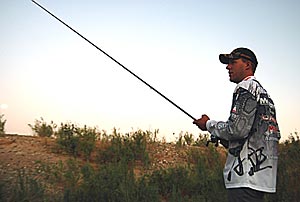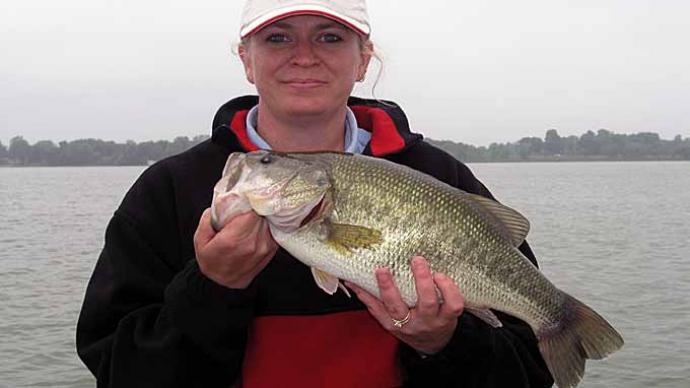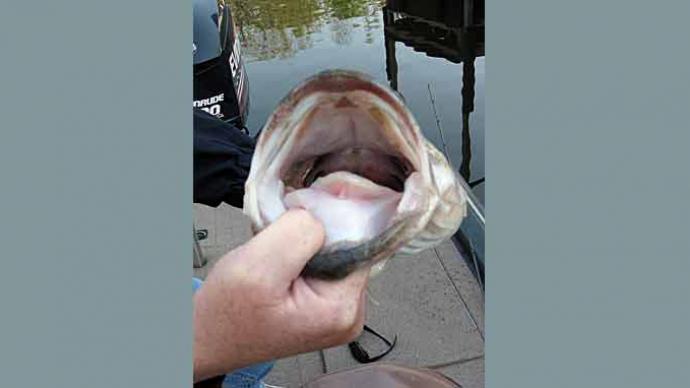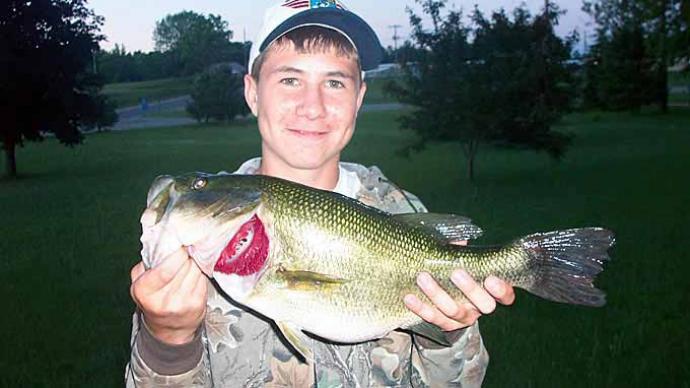
There are some very unique issues that govern the approaches you want to use in fishing for pre-spawn bass. To begin with, the phrase "pre-spawn bass fishing" means different things to different fishermen. The period can be loosely thought of as the patterns that begin with the emerging signs of spring. These include longer days, and thus longer periods of the warming rays of the sun for greater impact in protected waters.
The bass have followed the shad into what are generally their deeper haunts during cold-water periods. You can locate bass in this situation by simply reading a good depth finder, and soon discover the level the shad are holding at in cold weather. They may be locked on the bottom or, actually on warmer days, be somewhat more stratified into shallower layers but will usually still be over deeper water.
The bass follow the shad due to the accumulation of easy prey and their tendency is to form schools that hold in somewhat limited areas. In the pre-spawn period, bass start a movement that is not always governed by the movement of the shad. The one factor that does seem to govern their movement, and the important holding locations in this process, are pathways along structural changes in the lake bottom. The movement may occur along contour lines on the lake bottom or actually along defined channels. The important link in working a pre-spawn pattern is to try to find these so called "staging areas" in the lake. The term simply means that an area has been found where there is a major intersection in the paths traveled by bass in their annual shifts in location toward the shallower spawning areas. This routine has the particular advantages for the fisherman in that often there are considerable numbers of bass in one migratory holding area at one time. It is sometimes possible to actually find such holding areas by seeing the bass on your flasher. This gets a little more complex when you consider that not all bass go to the same level or retreat to deep water in the winter. But even those that hold in somewhat shallower levels during cold water conditions will migrate to shallow water or several shallower levels of holding spots before going into the true shallows in search of nesting areas.
The good news for fishermen is that bass in a pre-spawn staging area are often bass that are likely to feed. I have already indicated that the shift to shallower holding areas is not always linked to the migration of shad, thus you have to think of other options as possible food sources. The prime candidate is the crayfish. They are often found in a wide array of colors even in the same lake. However the most reproducible colors encountered in most species of crayfish are brown, with orange or red, and occasional blue tones. These are therefore good starting points for color selection in getting pre-spawn fish to strike when feeding. The other thing about a crayfish is that they may move fairly rapidly for a very short distance when disturbed, but they don't go very far at a time. Thus if you are trying to get a hit on a crayfish pattern, you may not want to make it look like it is jet propelled. When you couple these facts with the knowledge that the water temperature is still cold, or the bass would already be in the shallows, then a clear suggestion evolves as to how you should work a lure when fishing for these fish slowly. Of course baits that are ideal for such presentation are the soft plastics such as craw worms, lizards, and probably the most important-jig and pig type baits.
Your game plan should be to keep the bait in the area you feel is the most likely to be representing the strike zone, based on depth, and maybe even data from your fish finder. I made an issue of the value in using a color combination which may mimic a crayfish, but that is of lessening value if you are fishing staging areas of pre-spawn bass that are in deeper water, or in more off color water. Remember the deeper you go the less visual ability a bass has to detect tones. So when there is low light due to depth or water color, one dark color is probably as good as another. On the other hand in clear water, or when the bass are in shallower staging areas the choice of color and tone of that color can make a major difference in the level of your success.
As the water warms the bass tend to move to shallower and shallower staging areas. Remember a bass is a member of the sunfish family. The reason I point this out is that the other various members of the sunfish family also start moving shallower with the impending spring. The smaller members of the sunfish family often spawn considerably later than their larger cousin, the largemouth bass, but their paths of migration toward the shallows will often cross at these staging areas as each shift toward shallower waters. This opens the door for the fisherman to exploit an additional series of colors, which represent these food sources by using chartreuse colored baits. Again you have to remember that you are working fish that have recently been in the coldest water of the year, so their strike zone is usually smaller than it will be in warmer water conditions. So when working bream colors, whether using a crankbait or a spinner, use a deliberately slow retrieve. If the conditions of visibility are poor use a larger size crank, or slow roll a chartreuse spinner with oversized blades.
The very positive part about fishing the pre-spawn fish is that you usually can catch considerable numbers of bass when you find a staging area. The pattern can also hold up for several days, or even weeks if everything else stays constant. However you have to always keep in mind the fact that changes in conditions can also dramatically alter the holding locations of the schools of bass from one day to the other. A frontal passage may cause the fish to get lockjaw even if they are still in the same area. If the front is severe enough to appreciably affect the water temperature, then the bass may actually shift to a deeper holding area. I have also seen the opposite in that a warm rain in the late winter, or early spring will have a dramatic effect as the runoff changes the water temperature. The holding areas then tend to shift toward a shallower pattern even if the air temperature shifts back during a colder series of days. Just as in the fall an influx of warm or cold runoff can more rapidly affect the water temperature,than the impact caused by days of sustained cooler or warmer air temperatures.
I have always convinced myself that pre-spawn bass shifting from deeper to shallower water are catchable fish while those that are dropping back to deeper holding areas are much harder to catch. In fact to actually force a strike it may be necessary to let the jig and pig, or lizard stay in one position for a considerable period of time before slightly working it forward. This type of approach works best any time the bass have a very restricted strike zone and really have to be forced to hit. The bass may not have really moved very far from a staging area, or even may still be on the spot, but their feeding activity has shut down. If the area has produced fish before a frontal passage then shift to a vertical presentation, which is more likely to force a hit. A spoon or Little'George will give you the maximum presentation time in the strike zone, and therefore the best chance of triggering a strike. Even if you can force a hit under these adverse conditions it may be a totally different feel than that you would encounter from a more aggressive fish. Be very sensitive to any slight variation in the way the line or bait feels. You have to set the hook when you feel the slightest pressure, or even the lack of pressure which may indicate that a bass has the bait in his mouth, and not doing much with his "captured" prey but holding it from escape.
As the days lengthen there will be more reliable shifts of the schools of pre-spawn bass toward the spawning area. These bass become more aggressive feeders, not only because of the effect of the increase of the surrounding water temperature on their metabolic rate (their rate of using food stores for energy,) but also because of the related need to feed and store energy for the impending spawn.
The use of a temperature gauge is obviously very important in getting a read of possible environmental motivation for the movement toward the shallows. But also bear in mind that all bass do not follow the same time clock. In other words some are earlier spawners than their cousins. However a period on each lake will occur when most are on the nest in a given area of the lake. This may be several weeks apart if there is a considerable difference in the potential of a given shallow area to warm up. This difference can be caused by factors such as differing times of exposure to daylight warming, or just the opposite where areas are kept cooler for longer periods due to them being subjected to more wave action, and thus a greater mixture of water with varying temperatures than occurs in protected areas. Even in the same area there will be some stragglers, which will spawn on into the early summer. The real constant is that the various staging areas will in general be used by many bass in that part of a lake, even if there are times where more will be holding on the spots than at other times during the migration. The catch is for you to find the depth where the greatest concentration of bass are holding for a given time, and make the presentation needed for getting them to strike.
Make a mental or written note of the time of your success at a given staging area. This should include what you used and how. This will make a good reference as a starting point for pre-spawn bass fishing in future years. On a given day when you have solved the puzzle and caught fish, take the time to sort out (with the use of a good map, preferably a topo) exactly the type of structure where you might have had success, and see if you can envision where that contour might lead to the next holding areas prior to their entrance into the true spawning areas. Things begin to come together when you realize that other similar places on the lake are where you should, and likely will produce the same results under the same conditions. Like many challenges in being successful at bass fishing, you will become better at solving the pre-spawn game plan when you do some off the lake planning before your trip, use your electronics to define temperature and depth, and then put the pieces together for reproducible results.
A final thought about fishing this time of year is that you are catching fish, which soon will be providing the stocking for the future fishery in the lake. So try to keep that in mind as you handle the fish, and hopefully carefully release them so they can go on to the next stage of their life cycle - the spawn.




